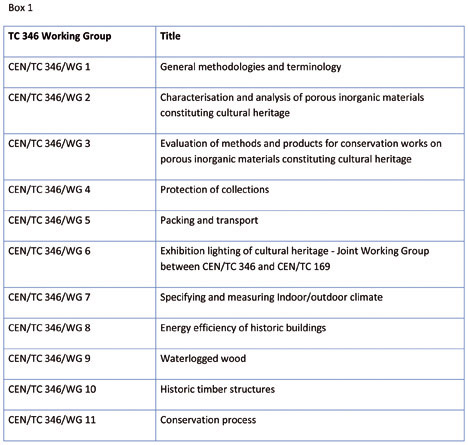Developing standards for cultural heritage buildings, monuments and objects
 Cultural heritage might seem an unusual area for the development of standards given the uniqueness and individuality of many historic buildings, monuments, structures and objects but over the last few years it has become a very active area.
Cultural heritage might seem an unusual area for the development of standards given the uniqueness and individuality of many historic buildings, monuments, structures and objects but over the last few years it has become a very active area.
Why are national and international standards important?
The question of why do we need standards for heritage and conservation is often asked. The answer is that conservation, like many other activities and businesses, has become increasingly global.
As it did, there was a need for a common set of conservation principles and these were developed and agreed in documents such as The Venice Charter (1966) (which stresses the importance of setting, respect for original fabric, precise documentation of any intervention, the significance of contributions from all periods to the building's character, and the maintenance of historic buildings for a socially useful purpose) and the UNESCO Recommendation for the Protection of Moveable Cultural Property (1978) (which defines the broad range of items that make up moveable cultural property and identifies measures to safeguard property and to indemnify in case of damage, alteration or loss of the property resulting from transport and exhibition, environmental conditions, handling, faulty packaging and other unfavourable conditions). A full list of charters can be found here.
As the trend towards globalisation has continued, a need for a common language and common framework within which to work has become important and it is this that the European Standards are trying to achieve. The intention is not to provide rigid and prescriptive solutions but to provide common questions and common ways to describe and evaluate cultural heritage. The UK standards take this further on and focus down on the UK's needs but still within the same common framework.
 British Standards for Conservation
British Standards for Conservation
In the UK we followed for many years the well established practices for many aspects of conservation of our cultural heritage. However, in the early 1990s it was decided that there should be some agreed guidance on the conservation principles and this was published in 1998 by the British Standards Institution (BSI) as BS 7913 Guide to the Principles of the Conservation of Historic Buildings.
Since 2000 there have been codes of practice for the cleaning of natural stones, brick, terracotta and concrete (BS 8221 Part 1) and for the surface repair of natural stones, brick and terracotta (BS 8221 Part 2). Both parts of BS 8221 were originally published in 2000 and Part 1 was revised and republished in 2012. BS 7913 is currently being revised and updated and the new version is due to be published at the end of this year. These are important documents and their development and revision is well supported by heritage organisations and practitioners who participate in BSI committee B/560 'Conservation of Tangible Cultural Heritage'. But the remit of B/560 is wider than historic buildings and it has overseen the revision of BS 5454 for the storage of archives into PD 5454 which gives recommendations for the storage and exhibition of documents, including books and other library materials.
 European Standards for Heritage Conservation
European Standards for Heritage Conservation
However, the area of greatest activity in recent years has been at a European level through the work of the European Committee for Standardisation (CEN) Technical Committee 346 'Conservation of Cultural Heritage'. This committee is led by the Italian Standards organisation (UNI) and supported by many European countries including the UK, France, Germany, Czech Republic, Italy, Norway, Sweden, Denmark, Spain and Greece. This committee is divided into 11 Working Groups (See Box 1) and some of these contain Task Groups who to date have completed 16 standards (see Box 2) with a further 25 standards being drafted for publication over the next five years covering both the 'immovable heritage' (buildings and structures) and 'moveable heritage' (artefacts, objects and books).
All of these standards have been, or will be, published by BSI as British Standards and so be available to owners and managers of heritage buildings and objects.
Looking to the future
The development of standards is set to continue for the foreseeable future - the work programme for CEN TC346 will be reviewed in 2015 but there doesn't seem to be any shortage of topics for the committee to work on. At a UK level, the publication of the revised version of BS 7913 planned for later this year will be an important step forward for the built heritage and the continuing interest in museum collections and exhibitions means that there is a continuing need to develop and apply standards to assess and protect them.
There are also new challenges for the cultural heritage - some coming from the concerns over climate change and the need to make buildings (including museums and collections) more energy efficient, and others from the challenge of new materials and new styles of building to conserve and protect for future generations.















